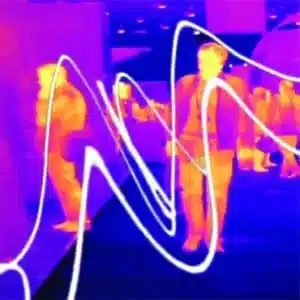Microwave Vs Infrared Activation Sensors – What’s the Difference?

When it comes to automatic door sensors, there are two primary options that you can choose from: microwave sensors and infrared sensors. But what exactly is the difference between these two sensors? And which would make a better door sensor?
These two types of motion sensors are the most common ones you’ll find in commercial buildings, and it’s not hard to figure out why– both work efficiently at detecting moving people and objects, and immediately opening automatic doors.
To answer these questions, let us first break down how each one works.
The Infrared Sensor
The infrared sensor works by measuring the infrared light radiating from the objects in its field of view. All objects with a temperature above absolute zero emit heat energy in the form of radiation. This radiation cannot be seen by the human eye, but can be detected by electronic devices like the infrared sensor.
The infrared sensor conducts an analysis of a room or surrounding areas, and looks for a change in infrared energy. Should it detect a change, such as the presence of a moving person in the proximity, it will emit a pulse activating the automatic door sensors, which in turn prompts the doors to open.
Infrared sensors are also known as Passive Infrared Sensors. ‘Passive’ here refers to the fact that these sensors do not emit or generate energy for detection purposes; they work simply by detecting infrared radiation emitted or reflected from objects.
The Microwave Sensor
The microwave movement sensor works quite differently to the infrared sensor. It applies the Doppler effect in that it sends out microwave signals and measures the length of time it takes for these signals to bounce off of surrounding objects and return to it. This echo time is what it uses to calculate the distance of stationary objects around it. It first establishes a baseline room or area analysis to detect the current distance of all surrounding objects. When something comes into the detection area thereby interrupting the microwave signals and altering the echo time, it perceives this as a change in distance from the object and this sets off its trigger.
The microwave sensor works much like a RADAR or SONAR system, sending out signals to measure its distance from objects. But the microwave sensor can also detect motion through wood, plastic, glass and most other construction materials except metal. Metal acts as a shield, creating dead zones behind them. This can be both an advantage and disadvantage to the microwave sensor.
Now that we know what the difference is between the two, it’s time to answer the question: which is better? The answer however isn’t clear cut:
Comparison
- Microwave sensors are highly sensitive and are able to detect motion even through thin walls. In this sense, they are more powerful than infrared sensors. But because of their sensitivity, they can easily get triggered erroneously or trigger false alarms. They sense movement in terms of speed and size, and so they can be triggered by things that normally shouldn’t trigger a sensor like trees blowing in the wind, moving drapery or movement beyond walls. Even fluorescent lighting, which emits detectable light particles, can activate the sensor and trigger it.
- Infrared sensors on the other hand, are less prone to such false alarms. But since they detect movement through heat and light, their performance can be affected by the ambient temperature. Often their sensitivity is compromised when the ambient temperature reaches beyond 35℃. The opposite happens in very cold temperatures wherein they become extremely sensitive. Microwave sensors are more stable in this sense, operating properly even at temperatures as low as -20℃ and as high as 45℃.
- Since infrared sensors detect movement through body heat – they are ideal for situations that require defined detection, such as in front of a doorway or down a walkway. But they must be installed in just the right position to provide effective coverage.
- Microwave sensors are great for just about any environment. They can provide fine motion-sensing whether in high heat, a large indoor commercial area, or large outdoor area that may be awkwardly shaped. This makes them one of the most versatile of sensors.
- Microwave sensors often have a longer lifespan than infrared sensors. They’re also one of the oldest and most relied on sensor technologies, but can be more expensive to run since they require more power.
- Since microwave sensors work at intervals – meaning they first emit signals and then receive them- it’s possible that someone or something moving fast enough may not be detected.
So which sensor would be better for your automatic door? Generally, infrared sensors are more suitable for smaller, more compact entryways and well-controlled, indoor spaces, whereas microwave ones are good for large areas. But who says you need to choose anyway?
With Rotech’s selection of commercial automatic door sensors, you can get both infrared and microwave technology in one! We also have a great selection of microwave only and infrared only door sensors. Take a look at our product range today!



